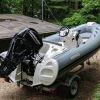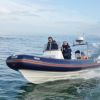 |
|
 08 January 2009, 23:34
08 January 2009, 23:34
|
#41
|
|
Member
Country: UK - England
Town: London/Oxford
Make: Ribcrafts
Length: 5m +
Engine: 150hp/2x115hp
MMSI: 235090215
Join Date: Oct 2002
Posts: 2,250
|
Quote:
Originally Posted by codprawn

The best thing to use has been banned - a Halon extinguisher. The green ones that you used to see on every public service vehicle.
It literally smothered the fire - a 1kg Halon was better than a 10kg CO2 and much better in the open air.
|
I just knew that would come up!!! 
|

|

|
 09 January 2009, 01:19
09 January 2009, 01:19
|
#42
|
|
Member
Country: Other
Town: Stanley, Falkland Is
Boat name: Seawolf
Make: Osprey Vipermax 5.8
Length: 5m +
Engine: Etec 150
Join Date: Mar 2006
Posts: 3,726
|
Interesting thread and with the lack of rescue around here (lifeboat? what dat den...) it is something I have given some thought to.
I think I'd probably try and shut off the fuel and power, try the extinguisher (though I have always thought it was probably p'ing in the wind, pretty much confirmed by the above comments) and then get up the bow on the tube ready to hop over the bow and hang on to the painter in the hope I had a boat left to climb back on to once the fire had gone out. I always carry the handheld clipped to my lifejacket so calling for help once off the boat wouldn't be a particular problem.
One idea I used once on a gas cooker fire (grilling steak, too much oil and heat, whooomph whole lot caught fire, flames coming up through the vents at the back of the cooker!) was a CO2 cylinder out of a Soda-Stream machine which I use for my beer barrels, this has a "push to operate" fitting on it and I banged this down onto the vents at the back of the cooker and the fire was out in about 3 seconds. I wondered about putting a metal fitting in the top of the outboard hood through to the inside that you could whack something like that onto and smother the fire inside. Not really got beyond the thought stage but it might be quite effective and there is a hell of a lot of CO2 in a soda stream cylinder.
I am a bit dubious of the water idea based on the fact that burning petrol floats on water...
__________________
A Boat is a hole in the water, surrounded by fibreglass, into which you throw money...
Sent from my Computer, using a keyboard and mouse
|

|

|
 09 January 2009, 01:36
09 January 2009, 01:36
|
#43
|
|
RIBnet admin team
Country: UK - England
Town: The wilds of Wiltshire
Boat name: Dominator
Make: SR5.4
Length: 7m +
Engine: Yam 85
MMSI: 235055163
Join Date: Jul 2005
Posts: 13,069
|
I've been wondering about the possibility of hooking up a bottle from a self-righting bag complete with the pull toggle and hose to mine.
Not sure what they are filled with-but if it's air I suspect I could get one filled with CO2 at my local welding shop. They seem to discharge a good multiple of the air space under my cowl and pretty quickly too.
What do people think?
__________________
Need spares,consoles,consumables,hire,training or even a new boat?
Please click HERE and HERE and support our Trade Members.
Join up as a Trade member or Supporter HERE
|

|

|
 09 January 2009, 02:06
09 January 2009, 02:06
|
#44
|
|
Member
Country: UK - N Ireland
Town: Bangor
Boat name: Mitigator
Make: XS
Length: 7m +
Engine: Mercury Verado 250
Join Date: Jun 2008
Posts: 72
|
As is so often the case with these scenarios, they can vary hugely on the day.
What caused the fire? What is fuelling it? What size engine is it? (At least on a larger engine, you probably have more boat to retreat down!)....
My thoughts are purely safety first:
Delegate one crew member to immediately send a quick Mayday call - could just be the thing that saves your life.
DO NOT remove cowling - they have been designed with this in mind, so leave it where it is to minimise oxygen supply. Instead, remove potential fuel for the fire. If it is a small engine and it is not a major fire (yet!) you could try and remove fuel line - there is obviously a risk associated with this. A better bet (especially with larger engines that cannot be easily disconnected) is to use a trusty pair of mole grips and clamp the fuel line shut as close to the engine as it is safe to do so. I would strongly advise against cutting the fuel line - you will end up with a substantial amount of fuel sloshing in the bottom of the boat just waiting to go "whoomph"!
The next decision is whether to shut off all electrics (ignition sources?) or to leave the engine running to help remove fuel until fire goes out. Tricky, but there is something to be said for trying to get as much fuel burnt in the cylinders and then out the exhaust, rather than allowing all the residual fuel (and there can be quite a bit!) to just burn away. An added advantage is that you can turn the boat for shore/help and the movement of air past the boat will cause fire to be held at the back and be blown away from the crew. Also, the nose up attitude of the boat will keep any burning liquids spilling from the engine at the transom - away from you and your fuel tanks.
I am sceptical as to how effective the average fire extinguisher would be, especialy now that Halon has been banned. Dry powder tends to be almost useless (if it goes off at all after a year or three of bouncing about and compacting in an exposed RIB). If the cowling is doing a good job holding back the flames, then you might consider having a go at squirting an extinguisher into the intake, but the baffle effect designed in will cut the effectiveness hugely. That said, if flames are leaping, then bets are off and give it a go from a distance! I personally think I would tend towards safety first and protection of my crew - get the boat close to somewhere you can get safe, or get someone to come to you.
The boat/engine can always be replaced!
If the fire goes out (or if you don't like my theory about keeping engine going!!) turn battery off at isolator or disconnect it, removing potential ignition source. Leave cowling in place - removing it could cause fire to reignite dangerously! Hopefully, that will now be the status quo settled and steady until you can get off safely.
Of course, this is only my own take on things and as such comes with a health warning!! I am sure everyone has their own ideas - some entirely opposite to mine - but I would say that if it ever happens to you, take a few deep breaths and assess the situation before acting (except getting the Mayday call out - it can always be downgraded!!). A hasty yank at a cowling could cost you more than your good looks.....
Regds
Mike
__________________
|

|

|
 09 January 2009, 02:27
09 January 2009, 02:27
|
#45
|
|
Member
Country: UK - Wales
Town: swansea
Boat name: Too Blue
Make: BLANK
Length: 8m +
Engine: Suzuki DT225
Join Date: Mar 2004
Posts: 12,791
|
Quote:
Originally Posted by BogMonster

Interesting thread and with the lack of rescue around here (lifeboat? what dat den...) it is something I have given some thought to.
One idea I used once on a gas cooker fire (grilling steak, too much oil and heat, whooomph whole lot caught fire, flames coming up through the vents at the back of the cooker!) was a CO2 cylinder out of a Soda-Stream machine which I use for my beer barrels, this has a "push to operate" fitting on it and I banged this down onto the vents at the back of the cooker and the fire was out in about 3 seconds. I wondered about putting a metal fitting in the top of the outboard hood through to the inside that you could whack something like that onto and smother the fire inside. Not really got beyond the thought stage but it might be quite effective and there is a hell of a lot of CO2 in a soda stream cylinder.
|
I remember the fire brigade experimented with a spike type device to ram through the bonnet of a car which would then inject gas through the hole.
It would be quite easy to rig up a pipe under the engine cowling. prob best look at such setups from the rally world - using FM200 or similar.
I bet there are still some nice Halon units lying around in the Falklands somewhere!!!
__________________
|

|

|
 09 January 2009, 06:55
09 January 2009, 06:55
|
#47
|
|
Member
Country: UK - England
Town: Sheepy Parva
Boat name: Sadly Sold
Length: no boat
Join Date: Sep 2008
Posts: 1,731
|
Quote:
Originally Posted by bedajim

|
I feel the blanket idea has merit...you can use it protect yourself from the fire if necessary, or, if safe to do so, you can approach the fire protected by the blanket. In the first instance, I still feel that excluding the oxygen sounds safer than attempting to exclude the fuel. If the blanket puts out the fire - and therefore reduces the heat and the risk of getting burnt - then the next action might be to disconnect the fuel supply to reduce any remaining risks.
__________________
|

|

|
 09 January 2009, 08:40
09 January 2009, 08:40
|
#48
|
|
Member
Country: Greece
Town: Athens
Boat name: Maria
Make: Yam 3.30
Length: 5m +
Engine: Yamaha 15 HP 2stroke
Join Date: Nov 2008
Posts: 6
|
Water cannot put out the fire from leaking fuel etc.
The CO ext. only can.
Personally I used to have one extinguisher and later I bought a second one.
Now that I bought a Yam 3.30 I 'll put the big ext. on the bow bag in order to be away from the engine and reachable.
Also a blanket could be usefull to limit the extend of the fire and then with the ext try to put out the fire.
__________________
Soft inflatable fan :)
|

|

|
 09 January 2009, 10:45
09 January 2009, 10:45
|
#49
|
|
Member
Country: UK - England
Town: Reading
Boat name: N/A
Make: Cobra
Length: 7m +
Engine: Verado 200
Join Date: Jan 2008
Posts: 55
|
Quote:
Originally Posted by ktmakis

Water cannot put out the fire from leaking fuel etc.
The CO ext. only can.
Personally I used to have one extinguisher and later I bought a second one.
Now that I bought a Yam 3.30 I 'll put the big ext. on the bow bag in order to be away from the engine and reachable.
Also a blanket could be usefull to limit the extend of the fire and then with the ext try to put out the fire.
|
The blanket seems to have lots of advantages. As I understand it, the problem with using water is that it disperses the oil, petrol, whatever and spreads the fire but I wonder if a wet blanket would be useful in lowering the temperature and keeping the fire contained. The water would also serve to increase the time taken to burn through the material and could perhaps be "topped up" by throwing more water on?
__________________
|

|

|
 09 January 2009, 11:40
09 January 2009, 11:40
|
#50
|
|
Member
Country: UK - Scotland
Boat name: Wildheart
Make: Humber/Delta Seasafe
Length: 5m +
Engine: Merc 60 Clamshell
MMSI: 235068449
Join Date: Apr 2007
Posts: 4,671
|
You need to remove either the oxygen or the fuel. (and I mean anything that will burn, not just the petrol!) Removing ignition source will stop it restarting. The wet blanket works by preventing (or reducing sufficiently) further oxgen form getting to the fuel. Water works on wood & paper type fires becasue the wood / paper absorbs it & it cools down. Petrol & oil, however, float on water, so throwing water at a petrol or oil fire will just disperse it. You guys that managed your car / bike fire with water were lucky.
This discussion set me thinking about my "new" toy. The clamshell has about 8 foot of "sealed" joints around the casing. Or at least they were sealed when it was new.... Sealing that to prevent oxgen ingress would be a nightmare.
I agree keeping it ruinning to use the fuel would be good, BUT I an think of two engines that when the plufg was pulled (to empty carbs) will run for at least 2 mins. I donlt thing going WOT in that scenario would be the best idea?
Also agree the mole grips on fuel line sounds good, but just how buried in the seat are your tools, bearing in mind how often you use them compared to your waterproofs, lunch box, spare warps for mooring, camera etc etc that are prorobably lying on top of them......
I do like the soda stream idea tho....
__________________
|

|

|
 09 January 2009, 12:54
09 January 2009, 12:54
|
#51
|
|
Member
Country: UK - England
Town: New Milton
Boat name: Jianna
Make: Osprey
Length: 6m +
Engine: 200 E-TEC
MMSI: 235076954
Join Date: Sep 2004
Posts: 1,940
|
Outboard Fires
I wonder If there is anyone who is employed in the design/manufacture/distribution of outboards who could provide informed comment 
It would be nice to know what the manufacturers position is 
__________________
Ian
Dust creation specialist
|

|

|
 09 January 2009, 12:56
09 January 2009, 12:56
|
#52
|
|
Member
Country: UK - Scotland
Town: Aberdeenshire
Boat name: Kikican
Make: Vipermax 7
Length: 7m +
Engine: F250 / FT9.9 Aux
Join Date: Nov 2006
Posts: 250
|
I was considering one of these
http://www.firetrace.co.uk/
Cylinder in the console. Run the tube once around the inside of the console and then off down the conduit, up through the control umbilical and then once around the engine. All nicely hidden away + automatic if you wish.
I would have thought that if you have a built in tank, you should have a shutoff valve easily accessible forward of the driver's seat (so you can close it as you move away from the engine). Built in to the console for instance.
Richard
__________________
|

|

|
 09 January 2009, 13:05
09 January 2009, 13:05
|
#53
|
|
Member
Country: UK - England
Town: Sheepy Parva
Boat name: Sadly Sold
Length: no boat
Join Date: Sep 2008
Posts: 1,731
|
Quote:
Originally Posted by Richard Selman

I would have thought that if you have a built in tank, you should have a shutoff valve easily accessible
|
My Ribcraft has one of these accessible from inside the console
__________________
|

|

|
 09 January 2009, 16:20
09 January 2009, 16:20
|
#54
|
|
Member
Country: UK - Wales
Town: swansea
Boat name: Too Blue
Make: BLANK
Length: 8m +
Engine: Suzuki DT225
Join Date: Mar 2004
Posts: 12,791
|
Quote:
Originally Posted by 9D280

You need to remove either the oxygen or the fuel. (and I mean anything that will burn, not just the petrol!) Removing ignition source will stop it restarting. The wet blanket works by preventing (or reducing sufficiently) further oxgen form getting to the fuel. Water works on wood & paper type fires becasue the wood / paper absorbs it & it cools down. Petrol & oil, however, float on water, so throwing water at a petrol or oil fire will just disperse it. You guys that managed your car / bike fire with water were lucky.
|
Most ships have fire pumps - using plain sea water!!!
Have you ever seen the firebrigade putting out a burning car? We get lots around here!!!
They normally use just plain old water - yes they are trained and they have lots of water but there is quite a bit around a boat as well.
Even when a petrol station goes up they use just plain old water. Foam is obviously better but they don't have many foam tenders handy.
A fire in an oil refeinery - again no foam.
And finally a fire boat - I wonder where they get the water from???
Now obviously if you have something like a burning chip pan you don't just chuck a bucket of water over it - but you don't point a CO2 extinguisher at it either - you actually use something called common sense!!!
__________________
|

|

|
 09 January 2009, 16:37
09 January 2009, 16:37
|
#55
|
|
Member
Country: USA
Town: Oakland CA
Length: 3m +
Join Date: Feb 2005
Posts: 6,653
|
Quote:
Originally Posted by 9D280

You need to remove either the oxygen or the fuel. (and I mean anything that will burn, not just the petrol!)
|
The third option is to cool everything down so the fuel (burning material; not necessarily gasoline) is below the combustion temp. CO2 extinguishers partially do this. They also starve the fuel of O2.
jky
__________________
|

|

|
 09 January 2009, 16:38
09 January 2009, 16:38
|
#56
|
|
Member
Country: UK - England
Town: Sheepy Parva
Boat name: Sadly Sold
Length: no boat
Join Date: Sep 2008
Posts: 1,731
|
Quote:
Originally Posted by codprawn

Have you ever seen the firebrigade putting out a burning car?
Even when a petrol station goes up they use plain water
Fire in an oil refeinery - again no foam.
And finally a fire boat - I wonder where they get the water from???
|
My interest on this thread relates purely to an outboard motor fire on a RIB that is crewed by amateurs. I don't have access to high pressure, high flow water pumping equipment. I don't have fire fighting PPE and I'm not qualified or trained to tackle gas station fires, oil refinery fires or anything that a fire boat might tackle.
Thank you for contributing to an extremely informative thread but personally I'm favouring the RNLI advice of an extinguisher and a blanket.
__________________
|

|

|
 09 January 2009, 17:17
09 January 2009, 17:17
|
#57
|
|
Member
Country: UK - Wales
Town: swansea
Boat name: Too Blue
Make: BLANK
Length: 8m +
Engine: Suzuki DT225
Join Date: Mar 2004
Posts: 12,791
|
I am not qualified either but I would still use a bucket of water if I had nothing else to hand!!!
__________________
|

|

|
 09 January 2009, 17:35
09 January 2009, 17:35
|
#58
|
|
Member
Country: UK - Scotland
Town: Glasgow
Boat name: stramash
Make: Tornado
Length: 5m +
Engine: Etec 90
Join Date: Feb 2006
Posts: 5,090
|
So what is the consensus then ? a Co2 extinguisher and wet jacket or blanket and know where you can shut off your fuel line then ? and most scenarios should be a variant treatable by these methods, powder is a no no then ?
__________________
|

|

|
 09 January 2009, 17:45
09 January 2009, 17:45
|
#59
|
|
RIBnet admin team
Country: UK - England
Town: The wilds of Wiltshire
Boat name: Dominator
Make: SR5.4
Length: 7m +
Engine: Yam 85
MMSI: 235055163
Join Date: Jul 2005
Posts: 13,069
|
Quote:
Originally Posted by Bigmuz7

So what is the consensus then ? a Co2 extinguisher and wet jacket or blanket and know where you can shut off your fuel line then ? and most scenarios should be a variant treatable by these methods, powder is a no no then ?
|
I don't know.
Trouble is, CO2 extinguishers all seem to be huge in comparison with dry powder (hence what I said earlier about a self-righting bottle-it's a little smaller) The Firetrace quotes a 40 second response time. That seems a long time to me-hopefully I'd spot a problem and extinguish it before the firetrace even discharged. I can't see it being very easy to fit a firetrace where it's needed either (high up in the cowling to allow the heat to trigger it faster at a guess?)
I've got no doubt dry powder will work but it's not very nice to what it's sprayed on.Your chances of getting going again after using it on something minor like a spit back are going to be slim. However, I'd rather that than fry...
__________________
Need spares,consoles,consumables,hire,training or even a new boat?
Please click HERE and HERE and support our Trade Members.
Join up as a Trade member or Supporter HERE
|

|

|
 09 January 2009, 17:55
09 January 2009, 17:55
|
#60
|
|
Member
Country: UK - Wales
Town: swansea
Boat name: Too Blue
Make: BLANK
Length: 8m +
Engine: Suzuki DT225
Join Date: Mar 2004
Posts: 12,791
|
I don't know how effective CO2 will be - it will put the fire out but if the wiring has lit then it will need to be quenched.
A fire blanket or wet coat would be good but the best thing would be an access point to get into the engine without lifting off the cowl.
http://uk.youtube.com/profile?user=briggsys&view=videos
Here are some videos showing CO2 - dry powder and foam on a fuel fire. The foam is far better.
I carry 2x 2l foam extinguishers similar to these I found on Ebay for £10 each - bargain!!!
http://cgi.ebay.co.uk/2-LITRE-FOAM-T...QQcmdZViewItem
I have also bought 2 small chemical foam units from Tesco - they are made from aluminium and plastic so shouldn't rust. Claimed to be good on electrical and chip pan fires. Only £10 each.
http://www.fireangel.co.uk/Product.aspx?id=200
They look perfect for an outboard fire if you can get the stuff in there!!!
__________________
|

|

|
 |
|
 Posting Rules
Posting Rules
|
You may not post new threads
You may not post replies
You may not post attachments
You may not edit your posts
HTML code is Off
|
|
|
|
 Recent Discussions
Recent Discussions |
|
|
|
|
|
|
|
|
|
|
|
|
|
|
|
|
|
|
|
|
|
|
|
|
|
|
|
|
|
|
|
|
|









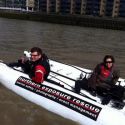 Eastern Thunder
Eastern Thunder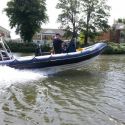 Northern Exposure 5
Northern Exposure 5



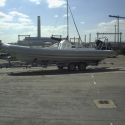 White Noise
White Noise





